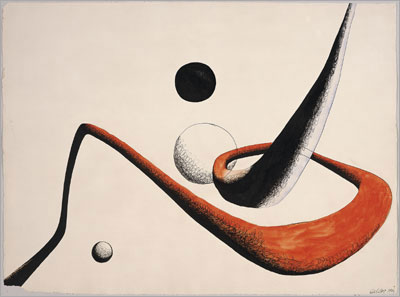

Alexander Calder, Tunnel
For many Surrealists, and especially Max Ernst, nature was an irrational profusion of forms in continual metamorphosis. Similar to his painted visions-at once lyrical and ominous-are Calder's watercolor and ink drawings with their embedded biomorphic shapes.
In 1959, Marcel Duchamp likened Calder's art to "the sublimation of a tree in the wind." Calder expressed his vision of the natural world by introducing the element of movement into art through mobiles and stabiles. Most notably, he created mobiles that ascend. At once monumental and delicate, they hover just above the floor while mimicking the growth of organic forms. Standing mobiles like Un effet du japonais (1940), resting on pedestals or platforms with their unfolding metal fronds, tremble ever so slightly in response to wind currents or vibrations. As the Surreal Calder himself proclaimed, "The aesthetic value of these objects cannot be arrived at by reasoning."
André Breton and Marcel Duchamp organized the last Surrealist exhibition in 1947, although Calder's affiliation with the Surrealists would continue for several decades. One of the last works in this exhibition is the suspended, biomorphic Untitled of 1945. To paraphrase his good friend Duchamp, what Calder brought to both Surrealist sculpture, in particular, and modern sensibility, in general, with such unpredictable mid-air arabesques was the lasting surprise of movement, the enchantment with something that is forever new and forever lyrical.
